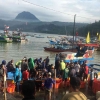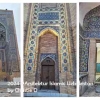Many tradition in Indonesia, that has become a custom for its society. Various traditions from Sabang to Merauke have different goals but have specific purposes, especially things that can have a good effect on their survival. Some of the traditions are ancestral heritage that should be persevered as well as possible. Tradition done by society is usually from nature. One example is that for coastal community, sea has become their wealth to survive in this world. Sea has given them life, so that this kind of nature should be saved and preserved. To save the sea, and as the gratitude of society for giving such wealth to survive.
One tradition which is still being carried out and sustainable up to now by coastal community in Jangkar's sea as a product of assimilation and acculturation of the culture of the Madurese and Javanese tribes is Petik laut. Firstly, the implementation of Petik laut was implemented in1901 and led by a shaman with a series of events. However, as time went by, the figures of Islam started to get involved such kyai, then this implementation of Petik laut contained some elements of Islam.
Petik laut which means picking, taking, or obtain marine products that are able to support fishermen. The tradition of petik laut usually held in the month of Muharram or Syuro in Javanese calendar. In the implementation of petik laut is not only participated by fishermen to ask for blessings of sustenance and safety, but also the farmers also enliven this ritual with their produce. Aryni Ayu W states that, Larung Sesaji is a petik laut tradition. The naming of petik lautt is related because this ceremony is also realized as a thanksgiving for the fishermen with all the things that have been given by the sea. There is also the name larung sesaji related to the procession of carrying out this ceremony which ends with the throwing of the offerings into the sea.
- Perspective of Islam
Islamic perspective refers to a viewpoint or interpretation of various aspects of life, society, ethics, and governance based on Islamic teachings, principles, and values. It encompasses the perspectives and understandings derived from the religion of Islam and its primary sources, namely the Quran and the Hadith.
According to Ferdinand de Saussure, the theory of semiotics has divided the sign (sign) into two parts, namely the signifier and the signified. The signifier is the imaged form in one's cognition, while the signified is the meaning understood by the sign user.
Petik Laut Jangkar is held by all societies of Jangkar. It is literally participated by coastal society and fisherman of Jangkar Sea. Petik laut is usually held once a year on 1 Suro or 1 Muharram. This agenda is held as a symbol of asking for such safety and gratitude which has given jangkar's society a place for surviving their life. Petik laut is done with a lot agendas. One agenda is usually done is offerings or people commonly know it as larung sesaji, which means that bringing offerings to the middle of the sea, usually there is a cow's head, food, and so on. This ritual is an expression of gratitude for the seafood obtained for a year, as well as the hope of getting more seafood without obstacles in the next year.
In Jangkar, petik laut is usually done with a lot of events. For example, before the day of petik laut is usually held a bazaar. Then a day before there will be a carnival, which is enlivened by local residents. Then on the anniversary, in the early morning there is a procession of the offering ceremony or larung sesaji which is followed by many people using boats or ships going away to the middle of the sea. Furthermore, at night there will be a different show every year, and continued by prayer and sholawat together and tausiyah by religious figures.
Besides, Larung sesaji means placing offerings into the sea. After previously being read such prayer. The goal, among others, is to offer gratitude for all the blessings. But sometimes it aims only to preserve tradition. Whereas, according to Islamic perspective, it must keep believing only in Allah, the offering of thanksgiving and the offering of all requests, and only Allah grants all requests. Basically, this tradition will not be contradictory to islam's beliefe, if all the events of it are not out of Islamic rules. So, every agenda should be started as first being thankful of what Allah has given as wealth as a tool for living in this world through the sea.
Talking about Larung sesaji is related to customary issues ('urf) in Islamic law. 'Urf is divided into 'urf sahih, if it does not conflict with Islamic law, and this is permissible. As well as 'urf fasid, if it is against Islamic sharia, and this is not permissible. Outside of issues of Islamic law, there are issues of faith. That is about faith and disbelief. If in practice there are elements that negate the existence of Allah, then it will result in disbelief. So, all the agendas of petik laut should be reminded that this kind of Larung sesaji should be aimed for being thankful to allah who has given them everything they need through the sea.
In semiotics study, Ferdinand de Saussure has divided into two, signified, and signifier. The signifier means that the sign user. In this study, Jangkar's society uses the sign of Petik laut, which is signified as an agenda of giving an offering to the sea as a symbol of gratitude to allah for giving them such safety and place to survive for life. So, signified means that, a specific meaning of something that is being understood by the sign user.









